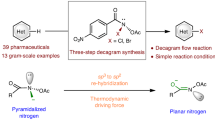Abstract
Human and Mills1 have generalized the procedure of Carré and Libermann2, who prepared, by adding an equimolecular amount of pyridine, the chlorides of the few acids which until then had withstood the action of thionyl chloride. Gerrard and French3 found it unnecessary to use an equimolecular amount of pyridine in the interaction of thionyl chloride and hydroxy compounds, and proposed to modify the Darzens' procedure4 by adding the thionyl chloride to a hydroxy compound with a few drops of a tertiary base, and heating for four hours at 65–80° C., which gives them the corresponding chloride.
This is a preview of subscription content, access via your institution
Access options
Subscribe to this journal
Receive 51 print issues and online access
$199.00 per year
only $3.90 per issue
Buy this article
- Purchase on Springer Link
- Instant access to full article PDF
Prices may be subject to local taxes which are calculated during checkout
Similar content being viewed by others
References
Human and Mills, Nature, 158, 876 (1946).
Carré, and Libermann, C.R. Acad. Sci. Paris, 199, 1422 (1934).
Gerrard and French, Nature, 159, 263 (1947).
Darzens, C.R. Acad. Sci. Paris, 152, 1314 (1912).
Libermann, Ion, 4, 40–41, 813 (Madrid, 1944).
Kyrides, J. Amer. Chem. Soc., 66, 1006 (1944).
Libermann, XIth Congress of Pure and Applied Chemistry, London, 1947 (in the press).
Author information
Authors and Affiliations
Rights and permissions
About this article
Cite this article
LIBERMANN, D. Interaction of Thionyl Chloride and Hydroxy Compounds. Nature 160, 903–904 (1947). https://doi.org/10.1038/160903a0
Issue Date:
DOI: https://doi.org/10.1038/160903a0
This article is cited by
-
Alkyl alpha-acyloxyacetates and propionates from soaps and alpha-halogeno esters
Journal of the American Oil Chemists Society (1950)
-
Structure of Cyclopropane
Nature (1948)
Comments
By submitting a comment you agree to abide by our Terms and Community Guidelines. If you find something abusive or that does not comply with our terms or guidelines please flag it as inappropriate.


